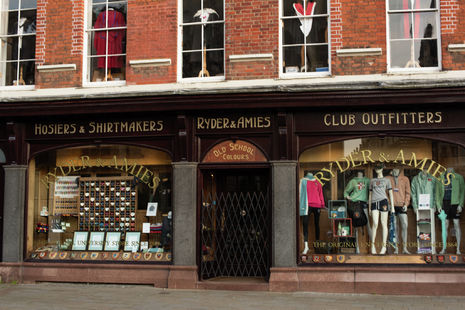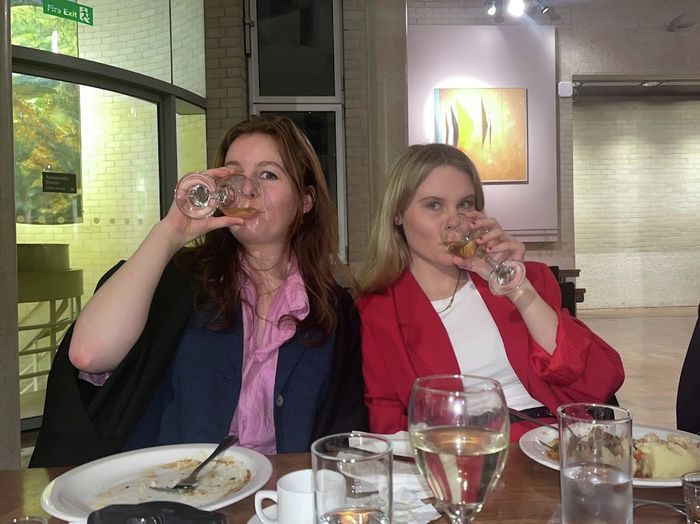From suits to sweatshirts: how formal traditions at Cambridge are changing
From pyjama formals to college sweatshirts, Josh Kazali looks into the evolving formal traditions of Cambridge

In 1932, Cambridge was in crisis. At least, it certainly seemed that way to Charles Franklyn, a British scholar of academic dress. That May, Cambridge’s Council of the Senate on Academical Dress met for the first time, introducing a new standardised system of Cambridge robes and gowns. Just weeks after that report, Franklyn wrote a fiery commentary in which he declared that traditions of academic regalia at the university “had fallen into a state of chaos, and needed complete revision and overhaul,” upon which he kindly offered an amended set of standards.
Franklyn’s 1970 monograph, Academical Dress, is filled with these impassioned pleas, not only to Cambridge, but practically every conceivable degree-granting institution. His fastidious (if slightly monomaniacal) attention to the traditions of academic dress feels almost comical in today’s Cambridge, where for most avenues of university life, our gowns have been shed for jumpers and jeans. I shudder to imagine Franklyn’s reaction to the modern Cambridge student.
The decline of formalwear – particularly menswear – has been well documented in fashion columns and blogs across the world, and is nowhere more apparent than on a stroll down Trinity Street. True, rowdy groups of post-formal students carry the mantle of tradition in the form of clip-on bow ties and the gowns which Franklyn fought so hard for. But as the historic high street has shifted more and more towards chic-casual shops and tourist merchandisers, it certainly seems that Cambridge is no longer the stiff, formal city that it once was. How have we arrived at this precarious position between tradition and modernity, and crucially, where do we go from here?
“Knowing full well what is ‘supposed’ to be happening here and doing the opposite”
Lauren Guye, a second-year English student at Gonville & Caius, told me that there is still a thrill to breaking the old codes of formality. As one of last year’s food and bar representatives for Caius, she helped plan a wide array of traditional and unconventional events, from the termly “Super Hall” – an über-classy, four-course affair – to a pyjama formal with burgers and chips, and even a murder mystery themed dinner night, complete with an elaborate plot surrounding the death of one John Caius.
Unsurprisingly, it was the latter, boundary-pushing events that were the most enjoyable for Guye to recount. “Part of the fun is definitely the novelty of it,” she told me, “knowing full well what is ‘supposed’ to be happening here and doing the opposite.” It was something that led Guye to the role in the first place: “How are we going to stand out? What hasn’t been done before?”
However, Guye also noted that for most students, informality is simply more comfortable. When, like at Caius, formal hall runs nearly every night, the elaborate traditions and codes of Cambridge rank low on the priorities of most students: “I could just turn up, grab my gown, and go straight from supervision,” said Guye. When you’re fitting in dinner with a full schedule, the rigorous rules of decorum can be more trouble than they’re worth, leading most to opt for casual clothes: “You do feel a little more relaxed.” And for the stress-addled scholar, relaxation can be a hard commodity to come by. For these students, the formality of tradition becomes a ready sacrifice.
Anthony Chamberlain, a partner at Ryder & Amies since his teenage years in the ’80s, has observed the evolving look of Cambridge students from his marvellous office view overlooking King’s Parade. “When I first started here, all the staff would be wearing three-piece suits,” Chamberlain told me, dressed now in a casual graphic tee. “You couldn’t even take your waistcoat off!” In his time as a university outfitter, he has seen the gradual decline of formal dress, and with it, many of the traditional tailoring institutions that decorated the city. “We were a tailoring business,” he said, gesturing to the upstairs part of the store, where students now collect their rented graduation gowns. “We had a large cutting table in there, a full time tailor in here. In the end, that just wasn’t profitable.”
“We’ve moved with the times”
“We’ve moved with the times,” Chamberlain told me. He credits the survival and success of Ryder & Amies to their flexibility in catering to the changing tastes of students, and crucially, investing in the ever-growing tourist market. “We still keep the university side of things going, which is what we enjoy, if I’m really honest. But alone, it’s not enough.” It’s a story told in the storefront windows which greet customers: on the left are dozens of sleek and shiny Cambridge club ties, the essence of university tradition; on the right, tote bags, jogging jumpers, even notebooks for the eager-eyed tourist. In the place of the suits which once decorated the store run new, and perhaps equally ubiquitous, puffers.
I would have forgiven Chamberlain for frustration, even resentment for the new order. After all, didn’t he feel pangs of sadness for the legacy which ran all the way back to his great-grandfather, Edwin Amies? I myself imagined the Cambridge of yore with more than a little idealism, with picturesque visions of academia springing to mind.
However, even when reminiscing, Chamberlain never begrudged the changing face of his store, and curbed my romanticism with a healthy reality check. “Look at the two of us,” he told me. “I’m sitting here in a t-shirt, you’re sitting here in a sweater and jeans.” Fashion is a capricious thing, and for Chamberlain, the preservation of the past should not preclude the greeting of the future. “Now, we have a much more diverse student body here,” he said, “it’s absolutely brilliant.” Ryder & Amies was successful precisely because they amended their conceptions of formality, and were open to new horizons. As Chamberlain put it: “The tradition just changes.”
In this way, maybe Cambridge doesn’t have to choose between the past and the future. “It is possible,” Guye told me, “to find the modern way of invoking a tradition.” She described the collision of past and present during formal hall: the surroundings and ceremony are as old as can be, but the food, conversation, and people are looking to the future. With more underrepresented and disadvantaged students attending Cambridge in recent years, university life has necessarily changed with the times. “But the candles are still there,” added Guye – a lingering glow of the past left behind.
Any article of clothing, from the fanciest suit to the ugliest sweater, is above all about fit. In recent years, Cambridge has re-evaluated its proverbial wardrobe of traditions, heritages and rituals. And perhaps the elaborate, meticulous and rigid code which Franklyn lauded – the silk and lace of class, hierarchy and order – have grown a bit tight around the collar. Unlike our clothes, our future does not come ready-to-wear: it is an endless and arduous process of tailoring in which we participate every day. Yet in time, it will hopefully yield a more comfortable and flattering garment which both looks and feels right.
 News / Cambridge bus strikes continue into new year16 January 2026
News / Cambridge bus strikes continue into new year16 January 2026 News / Uni members slam ‘totalitarian’ recommendation to stop vet course 15 January 2026
News / Uni members slam ‘totalitarian’ recommendation to stop vet course 15 January 2026 Science / Why smart students keep failing to quit smoking15 January 2026
Science / Why smart students keep failing to quit smoking15 January 2026 Interviews / The Cambridge Cupid: what’s the secret to a great date?14 January 2026
Interviews / The Cambridge Cupid: what’s the secret to a great date?14 January 2026 News / Local business in trademark battle with Uni over use of ‘Cambridge’17 January 2026
News / Local business in trademark battle with Uni over use of ‘Cambridge’17 January 2026










